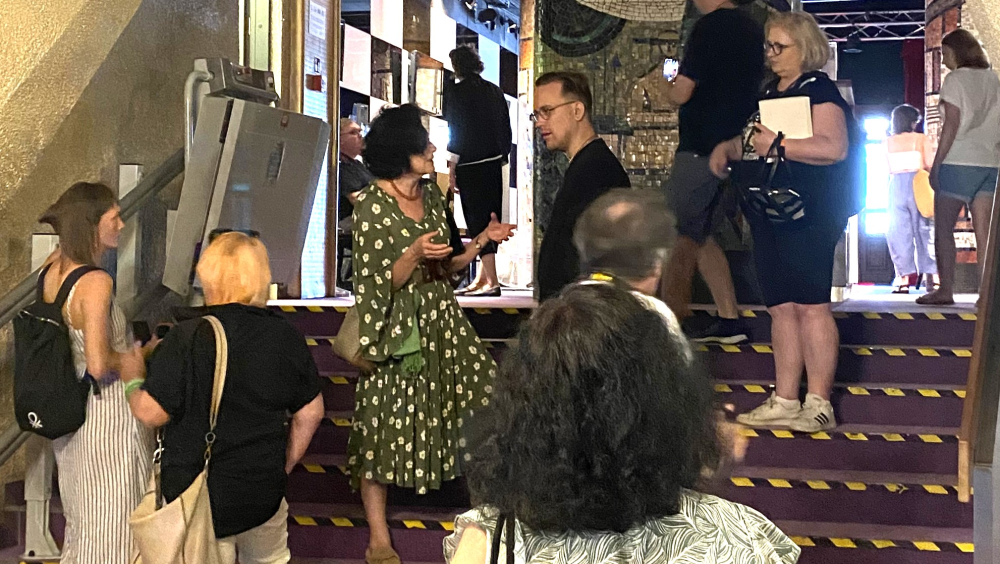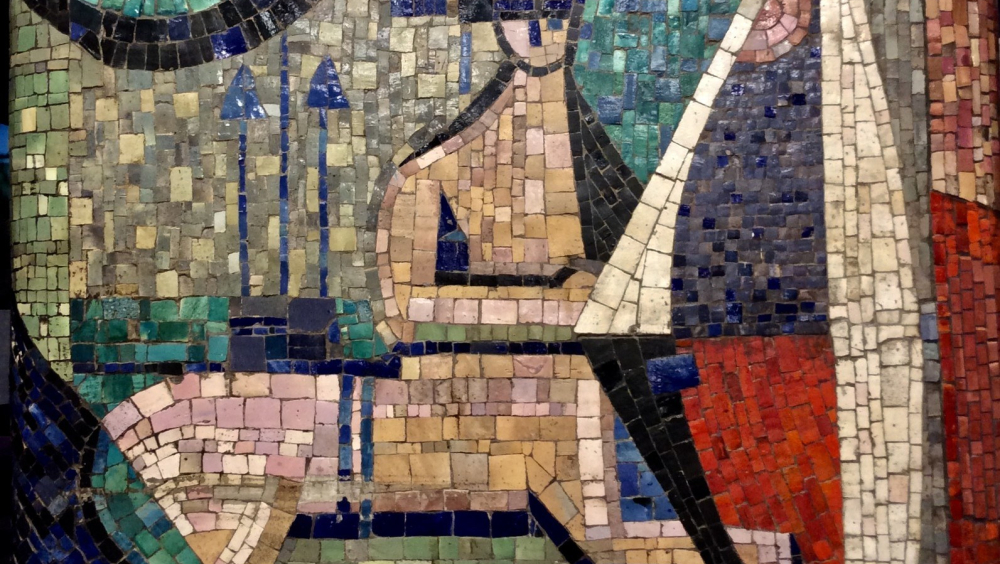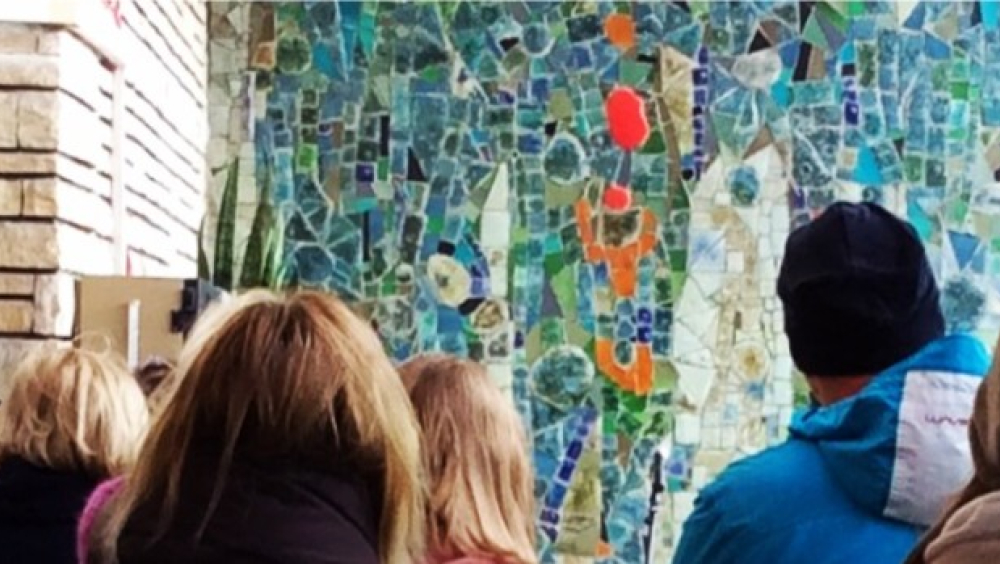The lost art of Warsaw's mosaics: discovering the monumental yet unseen
Our organization’s mission is: Culture brings people together, thus we bring together people with culture.
We feel strongly connected to one of Warsaw's districts, Praga Południe, full of housing estates and not so much cultural sites, we work with local communities, discovering local history and heritage, and promoting local artists.
One of them, Zbigniew Brodowski, was incredibly talented and left magnificent artworks, yet most Warsaw citizens don’t know him. Our goal is to organize events that through his enormous mosaics bring his name to public attention.
During communism, the introduction of art into public life was part of the political strategy to educate and bring colour into everyday life; these decorative forms later became a symbol of the past (hated) regime and were neglected or destroyed. This approach led to the inevitable loss of many works from the years 1970s - 1990s. It became a reality for the whole of Central and Eastern Europe as well as the Balkans, where similar sociopolitical changes were happening.
For European Heritage Days 2022, we decided to open a discussion on that topic. We managed to convince important stakeholders: the private company Polski Holding Obronny, (expert in special trade and strategic programs for weapon systems… and the owner of a monumental, beautiful mosaic made by Brodowski). Together with Wolskie Centrum Kultury, financial support from the Mazovian Marshall office, and technical support from Progresja Music Club (where famous European artists have gigs), we run a first open-to-public session with experts allowing participants to take pictures of the impressive mosaic. 40 (!) people came, some from distant parts of the city. We got reviews from many varsavianists and influencers. Most importantly we had an incredibly vibrant discussion about the art in the Communism era and the need to protect its heritage before it's gone.
Warsaw is famous for its past-wart, social realism heritage - the Palace of Culture and Science, MDM or Muranow district.
Whoever has visited the Polish capital city and knows its history, can easily be impressed by how the historical center was rebuilt after the Second World War. Our story starts with one of the buildings placed in the New Town, which is a UNESCO site. It is shimmering in shades of vibrant cobalt-turquoise tiles in the background to figures in motion symbolizing the affirmation of life - designed by famous artist Zofia Czarnocka-Kowalska. It was the first important work collaboration for the future master of mosaics, Zbigniew Brodowski.
We started our project by mapping local artists' workshops in Praga Poludnie district and realizing that one workshop is alive. Run by the Brodowski family - his daughter, Dorota Brodowska, also a qualified and award-winning painter and sculptor, and her children, one of them Maria, a talented, yet intellectually disabled poet - upholds the artistic traditions of its nestor.
The workshop is based in one of the first social housing estates developed in Poland (following a massive trend growing in Europe to create affordable, compact apartments for modern families). From the beginning, it became famous thanks to its unofficial name “An Estate of Homeless Lovers”. Stefan Ciechanowicz, an architect who designed it, included artistic workshops as an integral part of apartments and lived in one of them until recently. As a result, more than a dozen artists settled in the neighborhood establishing unofficial art colony. One of them was Zbigniew Brodowski.
We were deeply moved by the artistic flow in the Brodowski studio and wanted to present the majestic form of decorative art through the story of the family's unbroken traditions.
We aimed to invite Warsaw citizens to contemplate the unique character of Brodowski’s mosaic, which remains in perfect condition.
The more we discovered facts about mosaics in Warsaw, the more we knew that it’s the right direction. We decided to act in line with our patron’s character - Flaneur - inviting our followers and Warsaw history lovers to wander and explore city from an unknown perspective. We consulted our idea with the European Heritage Days organizer, who strongly supported our idea.
In 2022, an event took place during EDH. The building (seat of PHO company) is usually closed to the public but more importantly, it has a 4-meter-high, extremely beautiful glass mosaic of Zbigniew Brodowski, his last piece of art (1976). We developed an attractive program featuring experts - the historian of architecture, who brought closer the context of the PHO office building including architectural specifications, and the artist and heiress - Dorota Brodowska, who got into secrets of designing mosaics and shared childhood memories when her father involved her into creating small pieces of arts when he was developing his large-scale artworks.
Known for its role in the previous political system, Polski Holding Obronny (PHO) was like a mystery to public. How surprised we were to be welcomed with open arms and received huge support (including the simple fact that the CEO ordered the windows to be cleaned so that the light was better for admiring the mosaic).
Taking into account external conditions (bad weather) and geographical conditions (almost the outskirts of the city), almost 40 people came to listen to the story of Brodowski’s mosaic, take pictures, and discuss the role and importance of the socialist heritage in nowadays society. Our event got positive reviews from locals, active citizens and influencers, such as the author of Duchologia polska - a blog and famous among younger generations book on the cultural phenomena related to the transformation of Poland in the 1980s and 1990s as well as a fascination with Western Europe from a Central European perspective.
The interest was so huge that in next months we organized two more events to develop further those topics. One showcased this lost art of decorative forms in public spaces in Warsaw. It was run with Wolskie Centrum Kultury and the author of the popular blog Warszawskie Mozaiki, the second one was hosted in Muzeum Pragi, where we presented Zbigniew Brodowski's achievements and biography. What came as an unexpected result was that we were able to localize and confirm the authorship of to date unknown work based in a smaller polish town, Plock!
In 2023 we continued our work on promoting Brodowski heritage and organised another open to public event, this time in Teatr Kwadrat, showcasing to our public another original series of mosaics created by Brodowski. We invited an urbanist, Ewa Kalnoj-Ziajkowska, who gave a lecture on how Marszalkowska Street - one of the new central parts of Warsaw - was shaped on ruins after World War II. The neighborhood was built as a classic example of socialist-realist architecture combining living, work, and leisure functions. In her speech, Ewa brought up the topic of culture in a changing urban landscape and institutions being organically adapted inside buildings. Once again we held a lively discussion with participants, this time about the changing functions of the buildings and the preservation of the old aesthetics in the new conditions of urban life.
Furthermore, we also developed an arty website showcasing Brodowski and other artists from the art colony: https://okonasztuke.art/
In a wave of discovery of post-war modernism, which was characterized by great design, more and more people are becoming interested in the cultural heritage of the period and we aim to be the organization that maps and promotes artifacts located in public spaces including wall decorations and outdoor sculptures to attract attention of citizens and protect the heritage.
An outstanding example of incorporating the mosaic on the facades of a building is the Podkarpacie Philharmonic in Rzeszow, which Zbigniew Brodowski made with his team in 1974. Therefore, during EDD 2024, we want to develop the inclusive, artistic program, invite various experts, and build strong partnerships to celebrate the 50th anniversary of this institution and promote this unique artistic legacy to the community of inhabitants of Rzeszów.
The art of mosaics reaches to ancient times but it was during social communism that they became one of the most popular forms of art.
Monumental mosaics were mainly characteristic of post-war art in Poland and the GDR, these countries rebuilt after the destruction of the war and implemented new buildings in the spirit of modernism, which entailed the integration of architecture with works of art. Large windows designed with large facade wall planes provided the opportunity to incorporate large-scale mosaics into the design. The wall decorations and mosaics created during socialism in Europe represent a fascinating intersection of art, ideology, and cultural identity.
They often depicted scenes of laborers, farmers, and industrial workers engaged in activities that symbolized the socialist vision of unity and productivity. Using ceramics or glass made it possible to create multicolored, shimmering surfaces, which were supposed to cheer up passers-by. Across Eastern and Central Europe, these artworks became pervasive features of public spaces, serving as visual expressions of socialist ideals and narratives.
We are motivated to explore, document, and promote after-war mosaics because of the unknown fate of those artworks - even though they are part of the decoration of many buildings of public institutions building, they remain invisible. After political changes mosaics lost their colors and the power of the message, they became symbols of the toppled regime, not only out of step with the times but also tasteless. Very often they were ruined, and without proper documentation, any information about forms or authors was lost forever.
We strongly believe that by engaging with these artifacts thoughtfully, we can gain deeper insights into the complexities of European history and identity. We want to educate and involve inhabitants in discovering and caring for their local heritage as a part of the common good and history.


